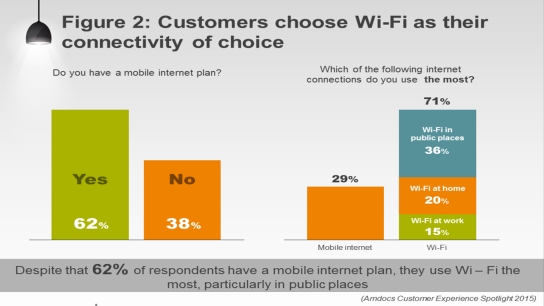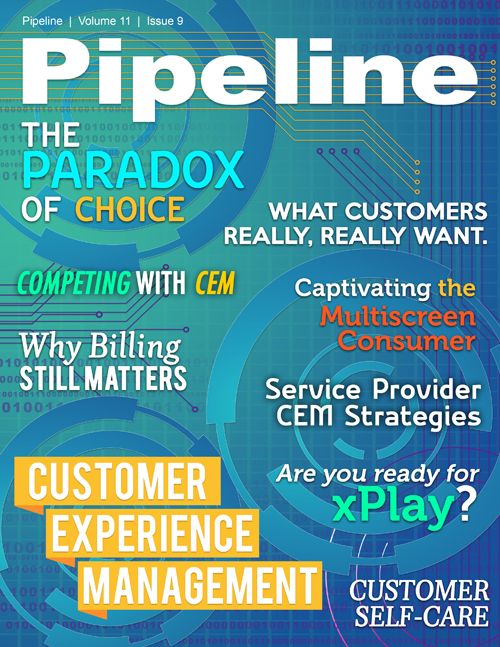Competing in All Dimensions with Customer Experience
The Wi-Fi threat
So perhaps service providers are not an endangered species after all? Well, it’s too early to celebrate, particularly for wireless providers who are now facing a new threat: Wi-Fi.
The Customer Experience Spotlight revealed that while almost two-thirds of respondents said they have a mobile internet plan, almost 75 percent of them said the connection they used.the most was Wi-Fi. This means mobile operators are losing in the “capacity” game, in which customers prefer Wi-Fi over using their operator’s network.

This is in line with industry figures (Cisco VNI Global Mobile Data Traffic Forecast, 2014 - 2019, released on February 3, 2015) showing that in 2014, 46 percent of total mobile data traffic was on Wi-Fi or Small Cells; by 2019, 54 percent of total mobile data traffic will be off-loaded.
When asked why, the respondents provided two main criteria: network quality and price. Even subscribers on an unlimited plan said network quality determined which type of connectivity they used. In countries where the mobile network is being developed and not yet of high quality (such as in some Eastern European countries), consumers showed an even greater surge towards Wi-Fi. In countries where 4G predominates (such as in the U.S. or some Western European countries), customers still tended to use Wi-Fi more, yet at lower percentages.
And we were surprised to learn that people most use Wi-Fi in public places (36 percent), followed by at home (20 percent) and at work (15 percent). Respondents said they enjoyed the fact they could sit on a train, at a café or on the beach, and use high-quality Wi-Fi as compared to their mobile network. This was particularly true of younger subscribers who showed higher percentages of using Wi-Fi in public places (65 percent) and less at home and work (especially students who enjoy Wi-Fi all over their college campus).
Importantly, there were also large variances in the type of services used when subscribers chose Wi-Fi over their mobile network. For low data-intensive applications, such as email, social media, mobile payments, the operator’s mobile network was the preferred choice. But for data-heavy apps, such as TV and VoIP, Wi-Fi was used by 90 percent of subscribers. This results in service providers losing out twice in terms of potential revenue: once for connectivity and again for the actual services consumed over Wi-Fi, which tend to compete directly with their own offerings.
To compete against this new Wi-Fi threat, service providers need to ensure a high-quality network experience, one that is better than Wi-Fi. Simplifying price plans and making the rating intuitive so customers are not afraid of bill shock. We found unlimited plan customers also feared bill shock, despite it being unrealistic, would also encourage customers to stay on the mobile network. Bundling Wi- Fi connectivity and the valuable content together with mobile internet plans will help service providers to bring customers back and increase their loyalty. And on top of this, mobile operators need to be part of the Wi-Fi game. They cannot leave it all to the wireline, cable or niche Wi-Fi players, and they should offer their own bundles with Wi-Fi and hotspots. According to a recent research by Real Wireless and Amdocs, carrier-grade Wi-Fi hotspots will grow from 14 percent today to 72 percent of overall Wi-Fi hotspots by 2018, allowing for strong network quality.
In this new world of customer experience, service providers have to make sure they are competing, in all dimensions.



















